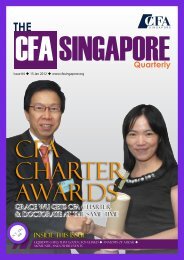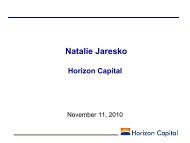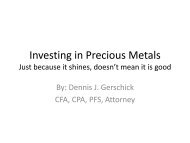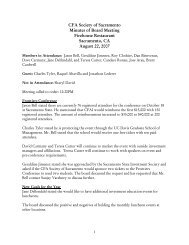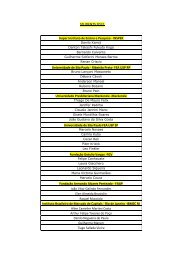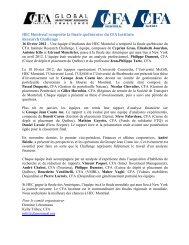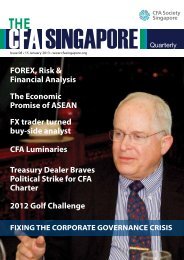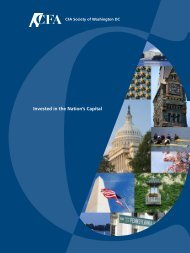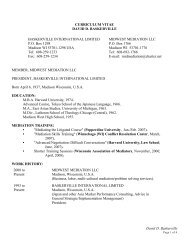Jeff Pantages - Societies
Jeff Pantages - Societies
Jeff Pantages - Societies
Create successful ePaper yourself
Turn your PDF publications into a flip-book with our unique Google optimized e-Paper software.
THE INVESTMENT WISDOM OFJOHN MAYNARD KEYNES (1883-1946)APCMSustainable Investment Thinking
Kings College, Cambridge UniversityAPCM Sustainable Investment Thinking 1
Keynes at CambridgeLetter to Lytton Strachey (1905)Marshall is continually pestering me toturn professional Economist and writesflattering remarks on my papers. Do youthink anything will come of it? I doubt it.I want to manage a railway or organizea Trust, or at least swindle the investingpublic; it is so easy and fascinating tomaster the principles of these things.APCMSustainable Investment Thinking2
The Bloomsbury GroupAPCM Sustainable Investment Thinking 3
WWI and the Treaty of VersaillesAPCM Sustainable Investment Thinking 4
Economic Consequences of the Peace• It was a sensation andbestseller throughout theworld• Characterized the treaty asa “Carthaginian Peace”• Germany treated unfairlyand economic terms of thetreaty will lead to ruin andmaybe worseAPCM Sustainable Investment Thinking 5
Keynes in the 1920’sHe was for a time in bad odor among grave persons.• Writing• Economic Journal, books, newspapers• Teaching• Cambridge, consulting (National Mutual and Provincial Insurance)• Investing• “A scientific gambler who played the cycle.”Roy Harrod (1950)APCM Sustainable Investment Thinking 6
Lydia and MaynardAPCM Sustainable Investment Thinking 7
Mr. and Mrs. Keynes – 1925APCM Sustainable Investment Thinking 8
Investing in the 1920’sMoney is a funny thing…with…a little extra knowledge andexperience of a special kind, it simply keeps rolling in.Letter to Florence Ada Keynes (1920)Win or lose, this high stakes gambling amuses me.A letter to his father while off in Italy (1920)Economists set themselves too easy, too useless a task, ifin tempestuous seasons they can only tell us that whenthe storm is long past, the ocean will be flat.A Tract on Monetary Reform (1924)APCM Sustainable Investment Thinking 9
Investing in the 1920’s…it may often profit the wisest (stock market player) toanticipate mob psychology rather than the real trend ofevents, and to ape unreason in anticipation…Thus, so longas the crowd can be relied on to act in a certain way, evenif it be misguided, it will be to the advantage of the betterinformedprofessional to act in the same way – a shortperiod aheadA Treatise on Money (1930)There will be no further crash in our lifetimeFrom biographer Robert Skidelski (1926)APCM Sustainable Investment Thinking 10
1929 Stock Market CrashWall Street did have a goyesterday. Did you readabout it? The biggest crashever recorded…I have beenin a thoroughly financialand disgusting state of mindall day.Keynes to LydiaOctober, 1929APCM Sustainable Investment Thinking 11
The Great Slump of 1930“The other was not a dream. This is a nightmare, whichwill pass away with the morning.”• The resources of nature and man’s devices are just as fertile andproductive as they ever were. We are as capable as before ofaffording for everyone a high standard of life. We were notpreviously deceived. But today we have involved ourselves in acolossal muddle, having blundered in the control of a delicatemachine, the working of which we do not understand.• “The machine has merely been jammed as a result of the muddle.”APCM Sustainable Investment Thinking 12
Magneto TroubleAPCM Sustainable Investment Thinking 13
The General Theory of EmploymentInterest and Money (1936)• The classical theorists resemble Euclidean geometers ina non-Euclidean world who, discovering that inexperience straight lines apparently parallel often meet,rebuke the lines for not keeping straight – as the onlyremedy for the unfortunate collisions which areoccurring. Yet, in truth, there is no remedy except tothrow over the axiom of parallels and to work out a non-Euclidean geometry.APCM Sustainable Investment Thinking 14
The General Theory of EmploymentInterest and Money (1936)• Classical economics rests on a fundamental error – that supplyand demand factors would ensure full employment.• Keynes viewed the economy as unstable and out of equilibrium inthe 30’s because of under-investment and over-savings rooted inthe psychology of uncertainty (see Ch. 12).• The solution to inadequate private demand was deficit spendingby the government.• He believed in “managed capitalism” and that he was savingcapitalism from socialism, communism and totalitarianism.• Keynesianism laid the intellectual foundation for a managed andwelfare-state oriented form of capitalism adopted by manycountries in the post WWII era.APCM Sustainable Investment Thinking 15
Keynes and WWIIAPCM Sustainable Investment Thinking 16
Bretton Woods 1944APCM Sustainable Investment Thinking 17
Mr. and Mrs. Keynes – 1946APCM Sustainable Investment Thinking 18
Investing in the 1930’s and Beyond• As time goes on I get more and more convinced that the right method in investmentis to put fairly large sums into enterprise which one thinks one knows somethingabout and in the management of which one thoroughly believes.Letter to Francis Scott Chairman Provincial Insurance (1934)• He argued that it was the “duty of serious investors to accept depreciation of theirholdings…an investor should be aiming primarily at long period results and judgedsolely by these.National Mutual felt otherwise and Keynes resigned in (1938)• I can only say that I was the principal inventor of credit cycle investment and haveseen it tried by five different parties acting in detail on distinctly different lines overa period of nearly twenty years, which has been full of ups and downs; and I havenot seen a single case of a success having been made of it.Letter to Richard Kahn (1938)• The central principal of investment is to go contrary to the general opinion, on thegrounds that if everyone agreed about its merit, the investment is inevitably toodear and therefore unattractive.Letter to Jasper Ridley (1944)APCM Sustainable Investment Thinking 19
Memorandum for the Estates Committee,Kings College Cambridge, 1938• I am clear that the idea of wholesale shifts is for various reasons[impractical] and indeed undesirable. Most of those who attempt it selltoo late and buy too late, and do both too often, incurring heavyexpenses and developing too unsettled and speculative a state of mind• (1) a careful selection of a few investments...having regard to theircheapness in relation to their probably actual and potential intrinsicvalue over a period of years ahead and in relation to alternativeinvestments at the time;• (2) a steadfast holding of these in fairly large units through thick andthin, perhaps for several years, until either they have fulfilled theirpromise or it is evident that they were purchased on a mistake;• (3) a balanced investment position, i.e. a variety of risks in spite ofindividual holdings being large, and if possible opposed risks (e.g. aholding of gold shares amongst other equities, since they are likely tomove in opposite directions when there are general fluctuations).APCM Sustainable Investment Thinking 20
End Part I: Biography and Personal Investing StylePart II: Keynes the Institutional InvestorAPCMSustainable Investment Thinking21
Keynes: The Stock Market Investor“His (Keynes) portfolios were idiosyncratic and approachunconventional. He was a leader among institutionalinvestors in making a substantial allocation to the newasset class, equities. Furthermore, we document a radicalchange in Keynes’ approach to investment which was tothe considerable benefit of subsequent performance.”David Chambers (Cambridge University) and Elroy Dimson (London Business School) - 2012APCM Sustainable Investment Thinking 22
Discretionary Portfolio: 1921 – 19463,1002,6002,1001,6001,100600U.K. Equity IndexAnnual Return: +9.0%Keynes vs. U.K. Equity IndexKeynesAnnual Return: +14.4%1001921 1923 1925 1927 1929 1931 1933 1935 1937 1939 1941 1943 1945Data: Keynes The Stock Market Investor, David Chambers and Elroy Dimson, 2012APCM Sustainable Investment Thinking 23
Top Down vs. Bottom UpSource: WSJ. David Chamber.University of Cambridge; Elroy Dimson, London Business SchoolAPCM Sustainable Investment Thinking 24
Change in Strategy?60%50%55%Turnover in Discretionary Portfolio40%30%20%30%10%0%14%1921-29 1930-39 1940-46APCM Sustainable Investment Thinking 25
% of Total PortfolioKeynes’ Concentrated Portfolio60%Top Holdings as a Percent of Total Portfolio50%40%46%49%30%20%10%0%33%21%15%11%1921-29 1930-39 1940-46Top Holding Top 5 HoldingsData: Keynes The Stock Market Investor, David Chambers and Elroy Dimson, 2012APCM Sustainable Investment Thinking 26
Keynes Major Investment Accomplishments1. Among first to allocate the majority of an institutionalportfolio to a new alternative asset class – equities2. Changed course from top down to bottom up3. Size and value tilts in portfolios – contrarian4. Concentrated bets – know what you own5. Terrific track record, in his spare time!6. Portfolio worth £500,000 ($25 MM 2012) upon deathAPCM Sustainable Investment Thinking 27
Keynes’ Investment Principles• Focus on the estimated intrinsic value of astock – rather than attempt to divinemarket trends• Ensure that a sufficiently large margin ofsafety exists before purchase• Apply independent judgment in valuingstocks – often a contrarian view• Limit transactions costs and ignore marketvolatility by maintaining a steadfast holdingof stocks• Practice a policy of portfolio concentrationby allocating to a few market stunners• Maintain the appropriate temperament bybalancing “equanimity and patience” withthe ability to act decisivelyAPCM Sustainable Investment Thinking 28
End Part II: Keynes the Institutional InvestorPart III: The General Theory of Employment,Interest and Money – Chapter 12APCMSustainable Investment Thinking29
Chapter 12:The State of Long Term Expectations – Section III• Our knowledge of the factors which will govern the yield of aninvestment some years hence is usually very slight and often negligible.• If human nature felt no temptation to take a chance, no satisfaction inconstructing a factory, a railway, a mine or a farm, there might not bemuch investment merely as a result of cold calculation.• The daily revaluations of the Stock Exchange, though they are primarilymade to facilitate transfers of old investments between one individualand another, inevitably exact a decisive influence on the rate of currentinvestment.• For there is no sense in building up a new enterprise at a cost greaterthan that which a similar existing enterprise can be purchased; whilstthere is an inducement to spend on a project what may seem like anextravagant sum, if it can be floated off on the stock exchange at animmediate profit. (Tobin’s Q?)APCM Sustainable Investment Thinking 30
Tobin’s Q (Market Value/Replacement Value)S e l l S t o c k sB u y S t o c k sAPCM Sustainable Investment Thinking 31
Chapter 12:The State of Long Term Expectations – Section V• Conventional valuation is established by the mass psychology of alarge number of ignorant individuals…the market will be subjectto waves of optimistic and pessimistic sentiment.• The social object of skilled investment should be to defeat thedark forces of time and ignorance which envelope our future.• The private object of the most skilled investor is to beat thegun…to outwit the crowd, and to pass the bad, or depreciating,half-crown to the other fellow.• A game of Old Maid, of Musical Chairs – a pastime in which he isvictor who passes the Old Maid to his neighbor before the game isover, who secures a chair for himself before the music stops.APCM Sustainable Investment Thinking 32
The State of Long Term Expectations – Section V:A Keynesian Beauty Contest• professional investmentmay be liked to thosenewspaper competitions inwhich the competitors haveto pick out the six prettiestfaces from a hundredphotographs, the prizebeing awarded to thecompetitor whose choicemost nearly corresponds tothe average preferences ofthe competitors as a wholeAPCM Sustainable Investment Thinking 33
Chapter 12:The State of Long Term Expectations – Section V• But won’t “serious-minded” long term investors dominate the“game players”?• Investments based on genuine long termexpectations is so difficult as to be practical• Human nature desires quick results• Institutional investors will not tolerate “long term investing”• Because the essence of this behavior is that it should be:eccentric, unconventional and rash in the eyes of averageopinion. If he is successful that will only confirm the general beliefin his rashness; and if in the short run he is unsuccessful, which isvery likely, he will not receive much mercy. Worldly wisdomteaches that it is better for reputation to fail conventionally thanto succeed unconventionally.APCM Sustainable Investment Thinking 34
Chapter 12:The State of Long Term Expectations – Section VI• Speculation … forecasting the psychology of the market• Enterprise … forecasting the prospective return of assetsover their whole life.• Speculators may do no harm as bubbles on a steadystream of enterprise. But the position is serious whenenterprise becomes the bubble on a whirlpool ofspeculation. When the capital development of acountry becomes a by-product of the activities of acasino, the job is likely to be ill-done.APCM Sustainable Investment Thinking 35
Chapter 12:The State of Long Term Expectations – Section VI• The spectacle of modern investment markets has sometimesmoved me towards the conclusion that to make thepurchase of an investment permanent and indissoluble, likemarriage…might be a useful remedy of our contemporaryevils. For this would force the investor to direct his mind tothe long term prospects...• The introduction of a substantial Government transfer tax onall transactions might prove the most serviceable reformavailable, with a view to mitigating the predominance ofspeculation in the United States. (Tobin tax?)APCM Sustainable Investment Thinking 36
Chapter 12:The State of Long Term Expectations – Section VII• Apart from instability due to speculation, there is instability due tohuman nature.• Our decision to do something can only be taken as a result ofanimal spirits – the spontaneous urge to action rather thaninaction, and not as the outcome of a weighted average ofquantitative benefits multiplied by quantitative probabilities.• This means that economic prosperity is excessively dependent ona political and social atmosphere which is congenial to theaverage business man.• If animal spirits are dimmed…leaving us to depend on nothing butmathematical expectation, enterprise will fade and die.APCM Sustainable Investment Thinking 37
Chapter 12:The State of Long Term Expectations – Section VIII• After giving full weight to the importance of changes in longterm expectations…I am now somewhat skeptical of thesuccess of a merely monetary policy directed towardsinfluencing the rate of interest.• I expect to see the State, which is in a position to calculatethe marginal efficiency of capital goods on long views and onthe basis of the general social advantage, taking an evergreater responsibility for directly organizing investment.APCM Sustainable Investment Thinking 38
The Final WordPractical men, who believe themselves to be quite exemptfrom any intellectual influences, are usually the slaves ofsome defunct economist. Madmen in authority, who hearvoices in the air, are distilling their frenzy from someacademic scribbler of a few years ago.APCM Sustainable Investment Thinking 39
AppendixAPCMSustainable Investment Thinking40
Keynes on Supply Side Economics• Nor should the argument seem strange that taxation may beso high as to defeat its object, and that, given sufficient timeto gather the fruits, a reduction of taxation will run a betterchance than an increase of balancing the budget.• For to take the opposite view today is to resemble amanufacturer who, running at a loss, decides to raise hisprice, and when his declining sales increase the loss,wrapping himself in the rectitude of plain arithmetic, decidesthat prudence requires him to raise the price still more.Keynes: The Means to Prosperity 1931APCM Sustainable Investment Thinking 41
Keynes on Hayek• The book, as it stands, seems to me to be one of themost frightful muddles I have ever read…Keynes review of Prices and Production 1931• In my opinion it is a grand book...Morally andphilosophically I find myself in agreement with virtuallythe whole of it: and not only in agreement with it, but indeeply moved agreement.Keynes on The Road to Serfdom 1944APCM Sustainable Investment Thinking 42
Keynes on FDR• President Roosevelt is magnificently right…to explore new paths”and “to achieve something better than the miserable confusionand unutterable waste of opportunity in which an obstinateadherence to ancient rules of thumb has engulfed us.Keynes in the Daily Mail 1933as FDR went off the gold standard• …what is the object of chasing the utilities around the lot everyother week?Keynes personal letter to FDR 1938• “I saw your friend Keynes. He left a whole rigmarole of figures. Hemust be a mathematician rather than a political economist.”FDR to his Labor Secretary 1934APCM Sustainable Investment Thinking 43
Keynes on Marxism• Marxism, he said, was …complicated hocus pocus. He said he had readMarx…as if it were a detective story trying to find some clue to an ideain it and never succeedingRecollection by Michael Straight• Lenin was certainly right. There is no subtler, no surer means ofoverturning the existing basis of society than to debauch the currency.The process engages all the hidden forces of economic law on the side ofdestruction, and does it in a manner which not one man in a million isable to diagnose.Economic Consequences of the Peace 1920• I can be influenced by what seems to me to be justice and good sense;but the class war will find me on the side of the educated bourgeoisie.A Short View of Russia 1925APCM Sustainable Investment Thinking 44
Internet Links• One Minute Keyneshttp://www.youtube.com/watch?feature=player_embedded&v=U1S9F3agsUA• Keynes vs. Hayekhttp://www.youtube.com/watch?v=d0nERTFo-SkAPCM Sustainable Investment Thinking 45



